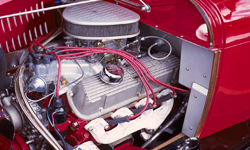
If you've ever flipped through a catalog for one of those expensive gadget stores, chances are you've encountered a spread advertising noise-canceling headphones. If so, you may remember that they work by detecting offensive noises with a microphone, duplicating the sound in almost every way, and piping it back into your ears. The only difference: the duplicated sound is purposely shifted 180 degrees out of phase from the original noise.
While the dueling sounds are of the same frequency and amplitude, the phase shift causes them to cancel each other out. To you, the listener, the original noise is rendered a barely audible whisper of its former self, allowing you to enjoy your music, or if you prefer, sweet silence.
That's pretty much the way active vibration control, which can be used in automobiles, works as well. In one system, from a company called Trelleborg Automotive, a microphone mounted in the car listens for vibrations within a pre-determined frequency range. Similar to the headphones example, the system responds with an equal but opposite counter-vibration. An electromagnetic actuator, called a "shaker," transmits the counter vibrations at select mounting points, for example, the steering wheel or the foot well of the floor pan.
Of course, a possible drawback of such a system is that it might work too well, and mask some of the symptoms of a truly ailing automobile. But, as mentioned earlier, chances are good that you'd get some other type of warning, such as a check engine light, to signal legitimate trouble.
As you just read, engine vibrations can be felt in the cockpit for lots of reasons. Lucky for us, the preceding innovations offer effective ways to battle unwanted engine clatter, rattles and rumbles.


